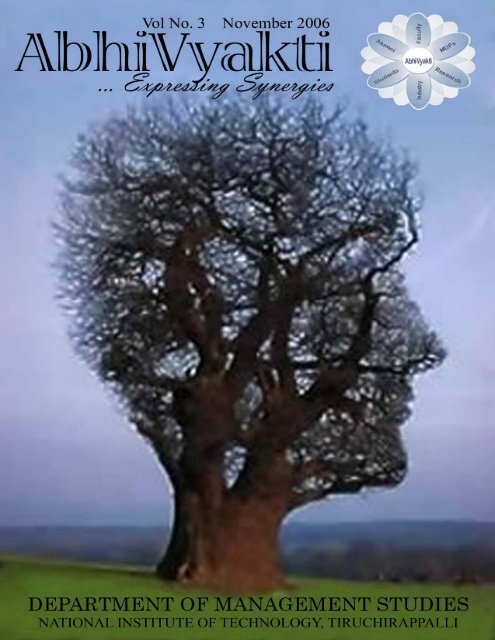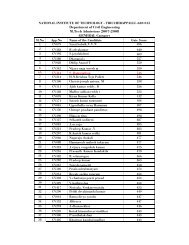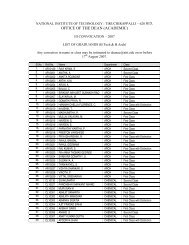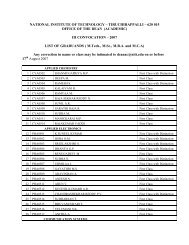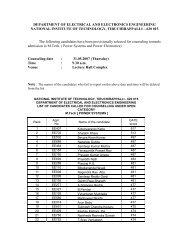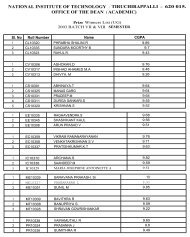Third Volume - National Institute of Technology, Tiruchirappalli
Third Volume - National Institute of Technology, Tiruchirappalli
Third Volume - National Institute of Technology, Tiruchirappalli
- No tags were found...
You also want an ePaper? Increase the reach of your titles
YUMPU automatically turns print PDFs into web optimized ePapers that Google loves.
ForewordThe third issue <strong>of</strong> AbhiVyakti is special in more ways than one. For starters, wehave a new team <strong>of</strong> juniors working with us from this issue onwards. As is thecase with any fresh batch <strong>of</strong> DoMS, the first year lot seems to be eternallybrimming with ideas for the Magazine. We hope that this team that takes overfrom us in about six months’ time will continue to have the support that has beenso generously extended to us by the DoMS fraternity. Along with the usual farethat every edition dishes out for you, this time we have an open invitation to all thealumni <strong>of</strong> DoMS from the DASFA members for the Alumni meet to be held on the11th <strong>of</strong> this month. DoMS looks forward to your presence in Ligature ’06.Take a peek into the present issue. Casting the spotlight on all the events at DoMSis our regular feature Eventura. Then we have an extremely informative andenlightening interview <strong>of</strong> Mr.Rajasekhar in La Recontre’. We would like toexpress our heartfelt gratitude to Mr.Rajasekhar and all the other alumni whomade this interview possible. This issue marks the launch <strong>of</strong> a new feature namedErudition. Erudition will primarily focus on the Guest lectures conducted for theDoMS students by the industry experts, facilitated by the faculty.Finesse, our segment catering to the palates <strong>of</strong> the finance enthusiasts focuses onthe mid term credit policy. Apart from this we also have an article onMicr<strong>of</strong>inance by Nitin Raj Garg (2nd year) reviewed by Ms.Usha Nandini,Lecturer, DoMS, NITT.The support and encouragement <strong>of</strong> the DoMS family for AbhiVyakti is unparalledand has been a constant source <strong>of</strong> inspiration for us to exceed our goals.The key to realizing a dream is to focus not on success but significance - and then eventhe small steps and little victories along your path will take on greater meaning.Oprah Winfrey
Contents Eventura ............................................................................. 1 La Recontre’ ...................................................................... 6 Alumni Interaction .......................................................... 13 Faculty Achievements ..................................................... 14 To Sir with Love ............................................................. 16 Erudition ........................................................................... 17 CII Managemantra- 2006 ............................................. 19 Finesse ................................................................................ 21 Financial Inclusion : Reaching the Unbanked .......... 24 Invitation to Ligature 06 ............................................... 27
EventuraEventura is back, with all the action that took place at DoMS after the last issue <strong>of</strong>AbhiVyakti. This time it was an events galore ranging from the fun andexcitement <strong>of</strong> the sports day to the pr<strong>of</strong>ound thought provoking tree plantationprogram. So here we go.Presentations, Seminars, Case Studies and Deadlines. If this sums up a day for theaverage MBA grad for you, then think again .The Sports Day on the 5th <strong>of</strong>August in DoMS, NITT was organized to let the future managers have a day <strong>of</strong>f inthe “fields”. A day <strong>of</strong> “All play and no work”.We work hard, we play harder!!There was an array <strong>of</strong> sporting activities to choose from and the list includedCricket, Table tennis and Badminton tournaments. Team work and coordinationseemed to be the order <strong>of</strong> the day when the seniors and the juniors displayedconsiderable talent in the sporting arena. The event brought with it oodles <strong>of</strong>enthusiasm and endorsed the camaraderie among the DoMS student community.If the mere utterance <strong>of</strong> a quiz contest gives you an adrenaline rush, then yoursearch ends at the Systems and Marketing clubs <strong>of</strong> DoMS. Infinit-e & Marketusprovide the right platform for the future managers to match their wits against eachother.1
Infinit-e Club organized a ‘Knowledge Sharing’ session on ‘Blogs’ presented bySatadal Payeng <strong>of</strong> 2 nd year followed by a systems quiz which had five teams eachconsisting <strong>of</strong> five members. There were three grueling rounds <strong>of</strong> quizzing with theteams battling it out for every single point with great zeal and spirit. The team thatemerged as the winner consisted <strong>of</strong> Sudhir, Suresh, Deepak, Aravindhan andPrabhu (All 1 st year).Marketus Club conducted a quiz contest for the marketing freaks, which waswell contested produced a nail biting finish. It consisted <strong>of</strong> a preliminary writtentest and five rounds <strong>of</strong> questions. The first four rounds included brands,personalities, logos, etc. the fifth round in the final was dumb charades whereinthe leading ad captions were given. The winners were Kishore & Swaminathan (Iyear).‘Testing time’ for the marketing enthusiasts…After the grueling Ice Breaker, a great Fresher’s Party was just what was neededto woo the juniors, and the seniors did it in style. The Fresher’s Party was held inthe Jenny’s residency. It started with a warm welcome address by the HOD, Dr. JRaja. The prizes for the various club activities, sports day & other events weredistributed. Our beloved Dominic Sir was also presented with a memento as hewas leaving for Malaysia on a five year study leave. DoMS family wishes him thevery best in all his future endeavors.2
Welcome aboard DoMS…!!Sing to myTunes …!!! Tapping to the right note … the(Luv and Debajit <strong>of</strong> 1 st year)senior girls stole the showThe cultural programs included a rendition by the 1 st years & a dance performanceby the senior girls. Sowmya & Rakesh (2 nd year) anchored the show. Keeping upthe tradition, the seniors hurled the “Boomerang” at the juniors which had thembaffled and nonplussed. The stage was set for some great jigs to the tunes <strong>of</strong> somepopular numbers leaving the students pleasantly exhausted and ravenous. TheFresher’s party marked yet another milestone in the journey <strong>of</strong> bliss calledfriendship.Come September and DoMS was caught in a frenzy <strong>of</strong> activities. Guest Lectures,Presentations and Seminars seemed to vie for the attention <strong>of</strong> the students. In themidst <strong>of</strong> the rigors <strong>of</strong> the curriculum the Department adorned a pious look on theeve <strong>of</strong> Saraswati Puja. Saraswati, the goddess <strong>of</strong> knowledge and learning,represents the free flow <strong>of</strong> wisdom and erudition.3
To mark the occasion, the DoMS fraternity celebrated this auspicious festival withgreat zeal and fervor. The celebrations took place in the department library, anideal choice for the event, considering it symbolizes the store house <strong>of</strong> learning.The occasion was presided over by the Honorable Director Dr. M Chidambaram.A special prayer by Mr. Murali and a devotional song rendition by Sowmya (2 ndyear) set the right note for the commencement <strong>of</strong> the Puja. The entire studentcommunity along with the faculty came together in a common prayer for the wellbeing and prosperity <strong>of</strong> one and all.It was Exams time in the month <strong>of</strong> October and Summer Project reviews kept theseniors busy for the better part <strong>of</strong> the day. On the 26 th <strong>of</strong> October 2006, theBusiness Line Club organized a guest lecture program for the 1 st year & 2 nd yearstudents. This was followed by a formal function in which Mr. L Ravindran,Founder, Managing Director & CEO <strong>of</strong> Wealth Max India Ltd. was thedistinguished Chief Guest. Dr. S H Ibrahim, Founder Head <strong>of</strong> DoMS, NITT andDr. M Chidambram, Director, NITT honored the event with their presence. TheDirector’s speech was followed by a very informative insight into the relationshipbetween equity & seasonality by Mr. Ravindran. The highlights <strong>of</strong> the occasionwere the two awards that were established.Pr<strong>of</strong>. Ibrahim & Dr Sitaraman Award will be awarded to the Best outgoing student<strong>of</strong> DoMS, NITT from the batch <strong>of</strong> 2005-07 onwards. A cash prize along with Goldmedal & citation will be given to the student with the highest CGPA. The Pr<strong>of</strong>.Thirumalaiarasan Award, a Gold Medal & citation, will be awarded to the Bestoutgoing Human Resource Management Student from the 2005-07 batch onwards.You will find something more in woods than in books.Trees and stones will teach you that which you cannever learn from masters.- Saint Bernard4
As a part <strong>of</strong> Isha Foundation’s Tree Plantation Campaign <strong>of</strong> planting seven lakh saplings,NIT Trichy has come forward to plant six thousand saplings in the campus. In congruencewith this, DoMS Tree plantation campaign was initiated on 26 th <strong>of</strong> Oct ’06 by Dr. S HIbrahim. Saplings were also planted by Mr. L.Ravindran; Mr. Chandrasekeran, RegionalManager, The Hindu and Dr. M Chidambaram. Head <strong>of</strong> the department, Dr. J. Raja,along with all the faculty and students <strong>of</strong> DoMS promised unstinted support to thisendeavor. Many students have come forward and donated generously towards this noblecause. The Department <strong>of</strong> Management Studies, NITT also presented a check <strong>of</strong> Rs.2000to the Director NITT, towards the Tree Plantation Program.For a greener NITTThat DoMS nurtures “humane” managers was evident by the huge turn out on thisoccasion. Signing <strong>of</strong>f on this pr<strong>of</strong>ound note, Eventura will be back to take forward thestory <strong>of</strong> DoMS.5
La Recontre’RajasekharDesignation: Consultant Senior Project ManagerClient: Fannie MaeProject: 'Securities Cost Basis Sub ledger'.This is part <strong>of</strong> a multi-million dollar project torestate the accounting books <strong>of</strong> Fannie Mae.Location: Washington D.C.Hi Raja, we take this opportunity to thank you on behalf <strong>of</strong> the DoMS community,for giving us the privilege <strong>of</strong> asking you a few questions about your associationwith DoMS and your illustrious career. We wish to learn & take guidance fromyour vast experience in your pr<strong>of</strong>essional life.Q. Let us begin with your academic background and your personal life. Tell us inbrief about your educational background and your roots.Nothing unusual about me. Hail from a Middle Class family; did ComputerScience Engineering from Coimbatore; pursued multiple MBA options duringcollege final year and was short listed for three institutes including REC, the othertwo being Bajaj in Mumbai and IIFT in Delhi. I could not make it to thoseinterviews due to typhoid and made it to dear REC, now NIT. Became NRI in1995, two years after leaving NIT. At present, I live and work in the suburbs <strong>of</strong>Washington D.C., USA. Family is my spouse and two kids.Q. Let me take you back to DoMS days, tell us something about DoMS in thosedays. How was the college life? The kind <strong>of</strong> batch compositions you had, the mostpopular teacher, specializations, placements etc, in a nut shell your DoMSexperience.6
We joined REC in 1991, when Dr. Manmohan Singh and Chidambaram were on asong liberalizing one sector after the other. The excitement was in the air.We were the first batch to go thru the trimester pattern. We were a small batch <strong>of</strong>28 fiercely individualistic youngsters. Most <strong>of</strong> us did not have any workexperience.We were also the first batch to get over 100% campus placements, though hardlyanyone continued with these companies for more than 2 years. The stars wereTISL (Tata IBM), TELCO, ONGC, Sundaram, and Parry. The highest <strong>of</strong>fer wasfrom TISL, about Rs. 6,000 per month (IIM peak <strong>of</strong>fer that year was 35,000).Q Hostel life is something which is very close to every student’s heart. How was itin those days, any special incident, which you would like to share?We were the first batch <strong>of</strong> students to occupy the PG hostel, I believe, it is nowcalled as the Beryl block. We had the luxury <strong>of</strong> single rooms; not sure if it is stillthe case. Plenty <strong>of</strong> cricket, Economic Times, Jenny’s residency kept usentertained.Q. Coming to your pr<strong>of</strong>essional life, please explain your career path in detail. Tellus about the learnings you had, defining moments, highs and lows. Anythingwhich you feel would help today’s budding MBA’s to pace their careerAll my thirteen years <strong>of</strong> experience, (other than the first 6 months, campusplacement job) have been in the financial services industry, covering RetailBanking, Operations, <strong>Technology</strong>, International Trade and Investment Banking. Ihave worked for many organizations including Citigroup, HSBC, JP MorganChase, Freddie Mac & Fannie Mae (Mortgage Backed Security Issuers in theUnited States)7
Geographically, I have lived in 3 foreign countries (Saudi Arabia, United ArabEmirates and now United States <strong>of</strong> America) and carried out direct projectassignments in about twenty countries (Saudi Arabia, UAE, Kuwait, Oman, Qatar,Jordan, Lebanon, Egypt, Uganda, Kenya, Tanzania, Mauritius, Nigeria, Canada,South Africa, USA, Singapore, Philippines, France, Algeria) and indirectly inanother dozen countries.I had strolled into Financial Services Industry, but once in there, I managed toresist the temptation <strong>of</strong> flip-flopping to other industries. This has paid richdividends - monetarily, job satisfaction and competitive advantage wise. Mysuggestion to a new MBA is to avoid ‘pond hopping’ between industries.Q. You have an extensive international work experience in the finance arena.What are the special capabilities one must posses to be successful in theinternational market?To my knowledge, the rules are not very different; it is the stringency <strong>of</strong> applyingthe rules that makes the difference.o Local competition for a job has been replaced by global competition. Beprepared to kiss umpteen frogs before finding the princess.o Global Market systematically exploits the weak. Tread cautiously. Awrong move can haunt you for years.o Develop a true core competency that that cannot be copied easily.Vertical skill set (by industry) has a premium over horizontal skill set(e.g. Java developer)o It is a solitary journey. Be absolutely truthful to yourself on what youknow, what you don’t know, and what you need to know.8
Q. Apart from regular academic degrees, there are lots <strong>of</strong> certifications like CFA,NCFM etc. being <strong>of</strong>fered these days (even you have few <strong>of</strong> them). Could you tellus how much <strong>of</strong> value these courses add to our MBA and at what point in thecareer graph should one consider doing them.One <strong>of</strong> the main weaknesses <strong>of</strong> MBA curriculum is, it is shallow in content (milewide and inch deep) with regard to Finance and Accounting, compared to aspecialized course like CFA. For example, even many <strong>of</strong> the seasoned (MBA)executives do not understand basic accounting terms like retained earnings, returnon equity or can read an income statement.A career conscious MBA in Financial Services Industry has to proactively addressthis gap with specialized certifications or self-reading.Ideally, one should aspire to do some sort <strong>of</strong> pr<strong>of</strong>essional certifications every threeto five years, in their line <strong>of</strong> work. In addition to reinforcing your corecompetency, it also sends out a message that you are serious about growth.If you aspire to be in investment banking, seriously consider CFA. If you intend tobe in Information <strong>Technology</strong>, PMI is basic. Pr<strong>of</strong>essional Certifications are a bigbusiness these days; so do spend some time researching before committing yourtime, energy and money.Incidentally, let me mention that I have three pr<strong>of</strong>essional certifications: PMIcertification for project management, CFPS (Certified Function Point Specialist)for s<strong>of</strong>tware size estimation and I have recently passed the CFA (CharteredFinancial Analyst) Level 1 examination.9
Q. Having worked all across the globe, what are the primary differences that yousee between the Indian financial market and the world market, especially nowwhen the Indian finance sector is booming.Despite the recent hype, Indian Financial Market is still in its infancy. The productrange and sophistication are limited (e.g. Derivatives), there is a weak heritage <strong>of</strong>trading, legal and regulatory systems (e.g. toothless laws to tackle insider trading),accounting standards are <strong>of</strong> questionable quality, and there is very high volatilityand transparency risk.Despite these weaknesses, I believe, investors should have at least a small portion<strong>of</strong> their investment portfolio in the Indian Markets, because <strong>of</strong> its scorching returnpossibilities. Not many countries in the world are positioned to have theireconomy doing manifold better in the next twenty years than the past twentyyears.Q. Are Indian financial institutions strong enough to compete with the globalplayers?There is a broad trend <strong>of</strong> consolidation among the global financial institutions.Citibank and Solomon Smith Barney merger, JP Morgan, Chase Manhattan andBank One Merger, Bank <strong>of</strong> America, Fleet Boston and MBNA merger areexamples. Citigroup assets have crossed 1 trillion, primarily due to mergers.Indian financial institutions are not strong enough to compete with these globalbehemoths. If you look at the balance sheet <strong>of</strong> Indian Banks, you will notice that<strong>of</strong>f balance sheet accounting are as high as 70% <strong>of</strong> the total bottom-line (for those<strong>of</strong> you who are not familiar with <strong>of</strong>f balance sheet entries, these are the contingentliabilities – example is issuance <strong>of</strong> a letter <strong>of</strong> credit)10
Most <strong>of</strong> the banks are undercapitalized and non-performing assets continue to behigher than global norms.Q. What would be your suggestions to an MBA graduate who aspires to make hiscareer in the financial sector? How should he pace his/her career. What are thethings which need to be given special importance?In the initial years, it is advisable to invest time and energy to develop a corecompetency within one <strong>of</strong> the niche segments in financial services sector. Given achoice, I would vote for investment banking, because <strong>of</strong> the lopsided earningpotential, but it is equally difficult to get a start. That is where an industry specificcertification like CFA can help.We cannot predict the subsequent years, since the vicissitudes <strong>of</strong> an MBA’s careercan take one anywhere in the map.Q. Could you throw some light on the extent <strong>of</strong> vulnerability <strong>of</strong> the Indian marketto the Fed rate fluctuations?US monetary policy, including the Fed rate changes sets in motion a series <strong>of</strong>macroeconomic changes. For example, when the rate goes up, foreign investorsflock to invest in the US, which tends to increase demand for dollars. (As a sidenote, foreign investors primarily invest in Mortgage Backed Securities <strong>of</strong>fered bythe clients for whom I work for – Freddie Mac and Fannie Mae. These two giantscollectively own over a trillion <strong>of</strong> US debts). This demand appreciates the dollarand the benefits flow to outsourcing firms like Infosys. The more Indian marketsget integrated with the global market, the more the impact.11
The extent <strong>of</strong> vulnerability is beyond my ken <strong>of</strong> knowledge – for that matter, eventhat <strong>of</strong> present Fed Chair Bernanke who once said “Economics is like trying tolearn how to repair a car with the engine running”.Q. In recent times you must have noticed lots <strong>of</strong> activities to bring the DOMSalumni together. What are your suggestions to improve and strengthen thiscommunity for the benefit <strong>of</strong> DOMS students and alumni who are spread allacross the globe and how can it be made a facilitator to open up global avenues forMBAs from DOMS?We had 100% placement as early as in 1993 and had an alumni meeting in Chennai soonafter. Subsequently, the initiators got busy and extra curricular activities including alumninetwork ebbed away and now it is springing back to life. The present flurry <strong>of</strong> alumniactivities appears to be going in the right direction. Once the initiatives evolve from beinga certain batch’s heroic efforts to a systematic process, the benefits will logically follow.Q. Your message to the students <strong>of</strong> DOMS.Read the book ‘Dig your well before you are thirsty’. I have regretted not readingit earlier in life.Q. Closing question, what kind <strong>of</strong> attachment do you have with your Alma Mater?Frankly; not as much as I would like to have. I, like most <strong>of</strong> the NRI’s, make shortvisits to India and don’t get an opportunity to visit Trichy.Feel free to shoot me an email at rajasek@yahoo.com, if you would like to discusssomething else with me. I may not have the bandwidth to respond immediately,but will reply for sure.Thank you for the opportunity.12
Alumni InteractionThe strong bonds that the alumni share with their alma-mater were once againbrought to light by the alumni interaction session in the month <strong>of</strong> August. Messrs.Lalit Mohan, Prigin and Shiva Chandran visited the campus on August 27 andgave insights into the industry to the first and second year students. The sessionwith the first year students dealt primarily with the actual work and the role they(students) will perform two years down the line. Though it was a generaldiscussion related to the work performed by the business analyst, it also touchedspecific areas like Enterprise Resource Planning (ERP) and Investment Banking(IB). The session with the second year students gave in depth information aboutthe disciplines <strong>of</strong> Knowledge Management & Investment Banking. The talk alsocentered on the relevance <strong>of</strong> areas like S<strong>of</strong>tware Testing for MBAs to gain aholistic view <strong>of</strong> the s<strong>of</strong>tware product. There was an informal chat where thealumni shared some <strong>of</strong> the fundas <strong>of</strong> tackling the placements successfully,particularly the dos and donts during the group discussions and interviews.Mr. Lalit Mohan also discussed about the content <strong>of</strong> the alumni website with thewebsite content team and the issues in the updating process. The formalities wereironed out and the team was inspired to work with renewed energy and vigor.13
Faculty Achievements: Moments <strong>of</strong> GloryThat DoMS creates a conducive atmosphere for learning not only for its studentsbut also for all its faculty members, is reflected in the glowing achievements <strong>of</strong>some <strong>of</strong> the Faculty members <strong>of</strong> DoMS, NITT.Conferences attendedDr. J Raja, A Suresh Kumar, and Dr. M Selvam, “Corporate Governance andPerformance – Indian Banking System”, Abstract accepted and paper underreview at International Conference on Business and Information, by Academy <strong>of</strong>Taiwan Information Systems Research.Dr. J Raja, Mr. N Thamaraiselvan, and A Sivaram, “How Do ConsumersEvaluate Brand Extensions? - Research Findings from India” Abstract acceptedand paper under review International Conference on Business and Information, byAcademy <strong>of</strong> Taiwan Information Systems Research.Dr. J Raja, Mr. N Thamaraiselvan, and R Vishakarajan, “Self ServiceTechnologies: Understanding Consumer Evaluations <strong>of</strong> ATMs ServiceEncounters”, Abstract accepted and paper under review at InternationalConference on Business and Information, by Academy <strong>of</strong> Taiwan InformationSystems Research.Dr. M J Xavier, Dr. J Raja and Ms. S Usha Nandhini “EntrepreneurshipDevelopment Through Corporate Interventions among Self Help Groups inIndia- The Case <strong>of</strong> HLL’s Project Shakti” was presented at the Conference onProduct and Market Development for Subsistence Marketplaces held at theUniversity <strong>of</strong> Illinois, Chicago during August 2-4, 200614
Ms. P Sridevi presented two papers “Emerging trends in technical education” &“Teaching, learning, experience methodologies.” in the Technical <strong>Institute</strong> atAurangabad.AwardsBest paper award: N. Thamaraiselvan, Dr J Raja and A Sivaram, “How doConsumers Evaluate Brand Extensions? –Research Findings from India”accepted for BAI 2006 International Conference on Business and Information atSingapore during July 12-14, 2006.Bringing glory to DoMSMr. N Durai Selvam was awarded German Academic Exchange Service (DAAD)Fellowship between June 2004 to September 2006 to do Academic Research atISAF, Technical University, Clausthal, Germany.Only as high as I reach can I grow,Only as far as I seek can I go,Only as deep as I look can I see,Only as much as I dream can I be.15
To Sir with Love‘At first instant, he seemed to be like any other ordinary teacher; one whocomes to the class, teaches the subject and leaves with loads <strong>of</strong> assignmentsfor a class full <strong>of</strong> agitated students. My impression changed completely as itdid for the rest <strong>of</strong> the class with time, when I got a chance to interact withhim. Dr. P D D Dominic is one <strong>of</strong> the most affable lecturers thatone could come across. Always ready to help, he imparted us the basics <strong>of</strong>quantitative methods almost with the same conviction as Da Vinci would addcolors to his creations. His calm and composed nature got the better <strong>of</strong> ouranxiety towards the subject and eventually students were quite elated afteranswering the quant exams.’- Saptarshi Sengupta (1 st year)Bid Adieu … you will be missed sirIt is said that talent can never be subdued and great people are destined for great things.Dominic sir was <strong>of</strong>fered the position <strong>of</strong> Asst. pr<strong>of</strong>essor in Petronas University which hegraciously accepted. We will always remember you sir and would cherish the valuablelessons you taught.16
EruditionAbhiVyakti has a new <strong>of</strong>fering this time around. The latest section that haveintroduced is “Erudition” which seeks to highlight the industry learning that takesplace inside the portals <strong>of</strong> DoMS. Here we present to you the Guest lecturesfacilitated by our esteemed faculty to enrich our knowledge with the experiences<strong>of</strong> the Industry stalwarts.Second year MBA (IV Trimester)Guest Lecture Series <strong>of</strong> TCS on S<strong>of</strong>tware Project ManagementThe series <strong>of</strong> guest lectures organized by Dr. G. Kannabiran pooled togetherresources from every functional area <strong>of</strong> S<strong>of</strong>tware Project Management such asTeam Management, Risk Management and Estimation & Quality Management.The Lectures drove home the importance <strong>of</strong> seeing the ‘big picture’ as far as thedomain <strong>of</strong> project management is concerned.TCS Guest Lecture Series: An Enriching experience indeed….17
Supply Chain Management Guest Lecture by Dr. K Ganesh from LMWThe lecture organized by Dr. M Punniyamoorthy introduced Supply Chain with anew perspective <strong>of</strong> a total systems approach and highlighted the importance <strong>of</strong>optimizing the chain using various mathematical models & heuristics.Guest Lecture on the Central Bank policies by Mr. ArunachalaramananThe Guest lecture on the central banking policies set about exploding the mythsregarding the functioning <strong>of</strong> the Apex bank. Mr. Arunachalaramanan started withthe central bank credit policy and went on to elucidate the credit appraisal methods<strong>of</strong> various banks. The entire length and breadth <strong>of</strong> the banking operations weredealt with in great detail.Services Marketing Guest lecture by Mr. XavierDr. M J Xavier an eminent Pr<strong>of</strong>essor <strong>of</strong> Marketing in <strong>Institute</strong> <strong>of</strong> FinancialManagement and Research (IFMR) Chennai, delivered an extremely edifyinglecture on important aspects <strong>of</strong> services marketing like Customer lifetime valueand Customer relationship marketing.Second year MBA (V Trimester)Guest lecture on Wealth Management by Mr. L RavindranThe guest lecture on “Wealth Management” was handled by Mr. L Ravindran,CEO, and MD <strong>of</strong> Wealth Max. He gave us an introduction <strong>of</strong> the whole sale debtmarket <strong>of</strong> NSE, and various means <strong>of</strong> wealth maximization avenues in the market.First year MBA (I Trimester)The first years had the privilege <strong>of</strong> spending a quality time with Dr. L S Ganesh(L.S.G) from I.I.T Madras. He was instrumental in providing insights into the field<strong>of</strong> systems. With a plethora <strong>of</strong> practical knowledge and real life experiences theguest lecture was inspiring and enriching at the same time18
CII Managemantra -2006Chennai was gloomy with incessant down pour. But a peep into the auditorium <strong>of</strong>Tidel park on the 27 th and 28 th October was enough to reveal the enthusiasm <strong>of</strong> thefuture managers from B-Schools across South India. It was the famous“Managemantra -2006” conducted by CII in which 300 odd students from 40business schools were all set to showcase their managerial acumen in the variousevents conducted.“Managemantra” is an annual event conducted by CII to promote the spirit <strong>of</strong> truemanagerial excellence and providing a platform for the students to interact withthe industry experts. This was an opportunity to learn and grow among a multitude<strong>of</strong> talents from all parts <strong>of</strong> the country. So how could DoMS miss it? Tenenthusiasts from final year MBA DoMS participated in the grand event.The event started with an inaugural session presided by Mr. Parasuraman R (Imm.Past Chairman, CII (SR)). Other eminent personalities who addressed thegathering were Ms. Anita Ramachandran (CEO, Cerebrus Consultants), Mr.Sreeram Iyer (CEO, Scope International (P) Ltd and Mr. Joseph Sigelman (CO-President, Office Tiger). This was followed by an industry-institute exchangeforum which dealt with “Generic competencies <strong>of</strong> Management Trainees – Whatcompanies look for in entry level MBAs”. The discussion panel consisted <strong>of</strong> MsSindhuja Shankar (Manager – HR World Bank, Chennai), Mr. Ajit Abraham (Head –Human Resources TAFE Ltd), Mr. Shyam C Raman (General Manager –HR Cholamandalam Financial Services), and Ms. Anitha Ramachandran (CEO,Cerebrus Consultants).19
The first day ended with active student participation in numerous competitionslike “Point Of View”, Business Quiz, Creative Idea presentations and BusinessPlan Presentation. The second day <strong>of</strong> the event started with yet another industryinstituteinteraction dealing with “Cultural dimension in companies from the CEOsperspective”. The panel consisted <strong>of</strong> Mr. Ravi Santhanam (MD, Hindustan motorsLtd), Mr. B Santhanam (MD, Saint Gobain Glass Ltd.), Mr. Vinay Deshpande(CEO, Encore S<strong>of</strong>tware Ltd.) and Mr. P K Mohapatra (CEO, technology businesssector, RPG enterprises). The mock interview following this interactive sessiondealt with the nuances <strong>of</strong> facing an interview. The panelists were Mr. DanielJebasingh (CEO, People Star Consultants), Mr. K N Ajith (HR, Sify Ltd) and MsAnu Zachariah (Trinitas Consulting).On the whole, this meet proved to be a great learning experience for theparticipants. The icing on the cake was the token <strong>of</strong> appreciation given by thecompanies in the form <strong>of</strong> intent letters to the participants based on theirperformance. The participants from DoMS received nine letters <strong>of</strong> intent.The list <strong>of</strong> students participated are mentioned below:BalakrishnanK, Manikandan V, Rajiv T, Ramanan K C V, Shiuli Chanda,Sowmya A, Sombabu I, Vikas Thakur, Vinodkrishna R and Vivek Krishnan R.20
Besides this, our economy is in a rapid expansion mode. India is in a situationwhere, the GDP growth is as high as 7-8%, with inflation ranging around 5-5.5%.This is higher than any other emerging market. RBI is trying to keep inflationwithin bounds without increasing the cost <strong>of</strong> borrowing, medium or long term.In the recent midterm policy, RBI has increased the repo rate (the rate at whichbank borrows money from RBI) by 25 basis. The message sent is loud and clear.The banks should look into their system and rebalance the credit/deposit ratio toreduce any possibility <strong>of</strong> bubble (like asset bubble) in the economy. RBI wants toslow down the growth <strong>of</strong> non-food credit from 30% to 20% for proper allocation<strong>of</strong> resources to all sections <strong>of</strong> economy .This would also keep a check on theinflationary prices in non-food items. However, the reverse repo (rate at whichbanks can park their surplus with RBI), bank rate & CRR are untouched with clearintention <strong>of</strong> not increasing the cost <strong>of</strong> government as well as the cost <strong>of</strong> mediumand long term borrowings. This will help the corporates in striking the rightbalance between inflation and the GDP growth rate.RBI has also allowed banks to borrow funds overseas (50% <strong>of</strong> Tier I capital or $10million), giving them more flexibility. This will act as an alternative for the banksto finance their credit to the companies going for organic overseas growth and inturn will ease the tight credit situation in the country.RBI is also interested in providing debt liquidity in government security market byallowing more foreign funds. This would however not be beneficial in the shortrun due to the negative return in government securities after adjusting the cost <strong>of</strong>foreign borrowing, but in the long run it will. Moreover, it will also help inproviding debt and liquidity to bond market as a ripple effect from the governmentsecurity market.22
RBI has sent a strong message to the world about Indian economic reforms byincorporating some <strong>of</strong> the recommendations <strong>of</strong> Tarapore report on fuller capitalaccount convertibility. This in turn will attract more FIIs and FDIs, providingmore flexibility to the corporates for asset-liability management. This is also thereason for the increase in the depository rate on NRO & FCCD just after thepolicy issue, to attract foreigners/NRI.Another noteworthy initiative by the RBI has been to allow short selling in debt &forex markets to banks and primary dealers, resulting in risk hedging, better pricediscovery and liquidity. This mid term credit policy can be considered as aninnovative step by RBI, which is enabling the sustenance <strong>of</strong> the high GDP growthrate without changing the bank rate and keeping inflation under check. RBI hasonce again proved that it harnesses the ability to change the way the worldperceives India.23
Financial Inclusion: Reaching the UnbankedNitin Raj Garg (2 nd year)(Reviewed by Ms. Usha Nandhini, Lecturer, DoMS, NITT)Poverty in literary sense is the inability <strong>of</strong> a person or a section <strong>of</strong> society to havethe minimum adequate standard <strong>of</strong> living. It's a phenomenon, which is not desiredby any body, but persists widely in the world and predominantly in less developedcountries like India. In the developed countries, there are islands <strong>of</strong> poverty in theocean <strong>of</strong> plenty where as in developing countries like India there are islands <strong>of</strong>riches in the ocean <strong>of</strong> poverty. Mass prosperity is the cherished dream <strong>of</strong> ourcountry but what prevails currently is the stigma <strong>of</strong> chronic poverty. If we gobehind the reasons <strong>of</strong> such massive existence <strong>of</strong> poverty even after 58 years <strong>of</strong>independence, then the only answer that sounds up is our system, which has notallowed the poor to cross the borders <strong>of</strong> poverty. The poor just like anyone else,need a diverse range <strong>of</strong> financial instruments to be able to build assets, stabilizeconsumption and shield themselves against risks. Financial services could enablethe poor to leverage their initiative, accelerating the process <strong>of</strong> building incomes,assets and economic security. However, conventional finance institutions seldomlend down-market, to serve the needs <strong>of</strong> low-income families and women-headedhouseholds. This leaves the poor with no other option but to address their need forfinancial services through a variety <strong>of</strong> financial relationships, mostly informal,which have serious limitations in terms <strong>of</strong> cost and risk. Credit is available frominformal moneylenders usually at a prohibitively high rate <strong>of</strong> interest. Savingsservices are available through a variety <strong>of</strong> informal relationships like savingsclubs, rotating savings and credit associations, and mutual insurance societies thathave a tendency to be erratic and insecure. They give loans only at rigid timeintervals and in strict amounts and also <strong>of</strong>ten result in loss <strong>of</strong> member money only.This lack <strong>of</strong> financial services has impact on the economic condition <strong>of</strong> the peopleas well as economic health <strong>of</strong> country. Financial exclusion is a symptom and cause<strong>of</strong> poverty.24
In the given scenario, the basic objective is to bring the people out <strong>of</strong> noninstitutionalframework and combat the menace <strong>of</strong> poverty. This can be achievedby bringing the rural mass in the folds <strong>of</strong> banking services. Towards this end,Reserve Bank <strong>of</strong> India (RBI) in its Annual Policy Statement <strong>of</strong> 2005-2006 andsubsequently in the mid term review <strong>of</strong> annual policy urged the bankers to providefacility <strong>of</strong> no frill accounts either with nil or very minimal balance requirements soas to cover vast section <strong>of</strong> rural population and align their existing practices withthe objective <strong>of</strong> "‘Financial Inclusion’’. Financial Inclusion is delivery <strong>of</strong>banking services at an affordable cost to the vast sections <strong>of</strong> disadvantaged andlow-income groups. It encompasses a gamut <strong>of</strong> facilities to be provided to ruralpeople in the form <strong>of</strong> savings facility (No frill Account), credit facility (GeneralCredit Card akin to Kisan Credit Card for business purpose and Overdraft forconsumption purpose) and default cleansing mechanism by One Time Settlement(OTS) for unwilful defaulters so that they can be given a chance to graduate out <strong>of</strong>poverty. The single gateway <strong>of</strong> a bank account can be used for several purposes bythe customer such as making small value remittances, borrowing, consumptionand business loans at low rate <strong>of</strong> interest and can also help in manifolddevelopment <strong>of</strong> banking business representing a win-win situation.A pilot project captioned <strong>National</strong> Pilot Project for Financial Inclusion (NPPFI)has been launched in the Union Territory <strong>of</strong> Pondicherry (UTP). The schemeenvisages providing banking services to all eligible population in UTP within theshortest span <strong>of</strong> time. The process <strong>of</strong> its implementation has started from 1 stJanuary 2006 and is targeted to be completed before 31st December 2006. A CoreCommittee (comprising representatives from Lead Bank <strong>of</strong> UTP and a few othermajor banks in the UT, representative from Rural Planning and Credit Department(RPCD), RBI) has been constituted to review the progress <strong>of</strong> NPPFI. The salientfeatures <strong>of</strong> the scheme include simplified KYC norms and account opening atdoorstep.25
To conclude, addressing the problem <strong>of</strong> financial exclusion will require a holisticapproach on the part <strong>of</strong> the bankers in creating awareness amongst the ruralmasses about financial products, education and advice on money and debtmanagement, savings and credit. Banks need to redesign their business strategiesto incorporate specific plans to promote financial inclusion treating it both abusiness opportunity as well as a Corporate Social Responsibility. They have tomake use <strong>of</strong> all available resources including technology as well as services <strong>of</strong> themicr<strong>of</strong>inance institutions and nongovernmental organizations. It may appearinitially that taking banking services to the weaker sections constituting “thebottom <strong>of</strong> the pyramid”, may not be pr<strong>of</strong>itable but even the relatively low marginson high volumes can be a very pr<strong>of</strong>itable proposition. The opportunities are plenty.Financial Inclusion can prove to be both pr<strong>of</strong>itable and viable business. Only thebankers should be ready to take up the gauntlet!26
DOMS ALUMNI STUDENTS &FACULTY ASSOCIATIONDEPARTMENT OF MANAGEMENT STUDIESNATIONAL INSTITUTE OF TECHNOLOGYTIRUCHIRAPPALLIRegn: SI. No 71/2006Dear Fellow Alumni,LIGATURE-05 marked a milestone in the history <strong>of</strong> DOMS. The last time wemet in Bangalore, we had formulated a road map to elevate DOMS to thehigher level <strong>of</strong> excellence. While we have taken some initiatives in thisdirection, lot more remains to be done.On behalf <strong>of</strong> DASFA board members, we cordially invite you to LIGATURE-06 where we the alumni get to reunite and reaffirm our commitment towardsour alma-mater besides discussing certain business matters.Looking forward to meet all <strong>of</strong> you once again in Chennai on 11 th Nov 2006.K T Thomas Dr. J. Raja Subramanian N. E.President, DASFA Vice-President, DASFA Secretary, DASFA(HOD, DOMS)Date: 11th November 2006Timing:09:00 AM ---------- 04:00 PMVenue: Hotel Gokulam Park, No. 67 (Old No. 14),1st Avenue, Ashok Nagar,On 100 Feet Road, Very Near to Ashok PillarPh: 044 - 24891273, 24894751, 24894752Chennai - 60008327


